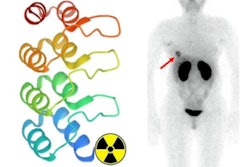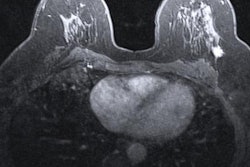
Artificial intelligence (AI) algorithms can improve the performance of breast MRI, both by helping women avoid benign biopsies and by predicting nodal metastasis so that clinicians can better plan treatment, according to research presented at the recent virtual American Roentgen Ray Society (ARRS) meeting.
In one study, researchers from the University of California, Los Angeles (UCLA) found that a machine-learning algorithm was able to help clinicians better categorize lesions with nonmass enhancement on breast MRI -- cutting the number of unnecessary biopsies by half.
"A machine-learning algorithm that models ... predictive variables of high-risk and malignant nonmass enhancements may halve the rate of benign biopsies," wrote a team led by Dr. Iram Dubin of the David Geffen School of Medicine at UCLA.
Nonmass enhancement on breast MRI can be confounding, as it "presents with a varied appearance and considerable overlap between benign, high-risk, and malignant lesions," the group noted. "Although imaging features such as distribution, internal enhancement, and kinetics are used to characterize nonmass enhancement, biopsy is often required for definitive diagnosis with benign biopsy rates greater than 50% in certain large studies," it wrote.
To investigate whether AI could mitigate this problem, the UCLA team conducted a study that included 100 nonmass enhancing lesions that clinicians biopsied using MRI between 2013 and 2019. Dubin's group included clinical, imaging, and pathological data in the study; based on pathology results, lesions were categorized as benign, high risk, or malignant.
The group developed a machine-learning algorithm that incorporated six variables predictive of high-risk and malignant nonmass enhancement lesions compared to benign ones. Variables included the following:
- Personal history of breast cancer
- Amount of fibroglandular tissue
- Background parenchymal enhancement
- Nonmass enhancement distribution
- Nonmass enhancement internal enhancement
- Nonmass enhancement delayed phase kinetics
The researchers assessed the model's performance using the area under the receiver operating curve (AUC) measure. Of the 100 biopsied lesions, 41 (41%) were benign, 29 (29%) were high-risk, and 30 (30%) were malignant.
Dubin and colleagues found an AUC value for the machine learning model of 0.81 and determined that, using an ideal cutoff value for sensitivity of 71% and a value of 82% for specificity, adding the algorithm to breast MRI analysis would reduce the rate of benign biopsies by 56%.
In a separate paper presented at ARRS 2021 about the benefits of using AI with breast MRI, a team from the University of Texas Southwestern Medical Center in Dallas found that a dynamic contrast enhanced (DCE)-MRI-based 4D convolutional neural network (CNN) helped predict nodal metastasis in breast cancer patients.
DCE-MRI is a common imaging workup tool for staging local breast cancer, but it can overestimate tumor size and may not correctly assess nodal chains or tumor phenotypes, a team led by Dr. Dogan Polat noted. That's where a good CNN could help.
"A robust imaging-based predictive model that assesses the presence of lymph node metastasis with significantly higher accuracy compared to current modalities is needed," the group explained. "This would provide a cost-effective tool that can reduce number of biopsies performed, carries no additional morbidity, and would facilitate treatment decisions in breast cancer patients."
Polat and colleagues conducted a study that included 367 women with primary invasive breast cancer who underwent DCE-MRI between July 2013 and July 2016. The team used a range of data taken from electronic health records to train the model, such as age, ER and HER2 status, and clinical and pathologic node status.
Of the 367 women, 61.9% had node-negative breast cancer and 38.1% had node-positive breast cancer. The researchers found that the CNN model performed well, especially when it came to sensitivity.
| Performance of 4D hybrid CNN model for differentiating between benign and malignant nodes on breast MRI | |||
| Task | AUC | Sensitivity | Specificity |
| Differentiating between clinical node negative and positive | 0.80 | 84% | 60% |
| Differentiating between pathological node negative and positive | 0.82 | 87% | 62% |
The findings could positively influence management of breast cancer patients, the authors wrote.
"Our results indicate that this model is a safe, efficient, and cost-effective tool to predict nodal status of the breast cancers, without further axillary imaging or diagnostic interventions," Polat and colleagues concluded.




.fFmgij6Hin.png?auto=compress%2Cformat&fit=crop&h=100&q=70&w=100)




.fFmgij6Hin.png?auto=compress%2Cformat&fit=crop&h=167&q=70&w=250)











